Suspension Fit For The UTV King
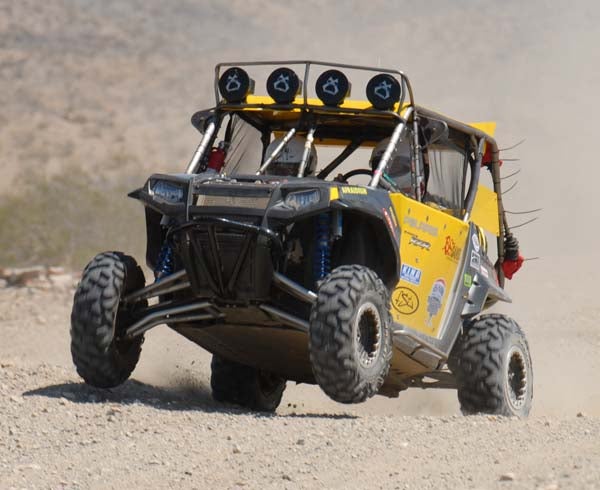
The proliferation of UTVs in off-road competition is perhaps a phenomenon unlike any other the sport has seen this decade. From the short courses to the desert, UTV racing has reached a level of activity best described as incendiary over the past two years. In addition to several UTV-specific series, such top-tier automotive off-road sanctions such as SCORE, CORR and BITD have all rolled out the welcome mat for the side-by-side crowd, and at least two brands – Polaris and Kawasaki – have initiated factory racing programs in one or more of these sanctions.
Dirt Sports recently took the opportunity to sample one of these factory-backed rides, the Tecate SCORE Baja 500-winning Polaris RZR of Mark Lindsay. A real estate agent from Flagstaff, Arizona, Lindsay and his Afraidium Racing team made history in 2008 by becoming the first UTV to even finish, let alone win, the 500.
Killing two birds with one stone, our opportunity to sample what is arguably the best UTV in the desert today coincided with a suspension test that Afraidium Racing had scheduled with legendary off-road shock absorber company King Shocks. For the past 18 years, King has been a true leader in the development and manufacture of off-road racing shocks, attracting a clientele of several of the sport’s top stars, such as reigning Tecate SCORE Baja 500 Baldwin, Tecate SCORE San Felipe 250 winner Brian Collins, Class 1 contender Damon Jeffries, CORR Champion Carl Renezeder, Curt and Kyle LeDuc and Evan Evans, just to name a few. But King is also heavily involved in the UTV market, and has been hard at work in developing shock absorbers for the more popular UTV makes and models. One of King’s house R&D cars is a Polaris RZR. When Lindsay contacted King and requested assistance in dialing in his suspension, the King guys agreed to meet him at the Stoddard Wells Off-Highway Vehicle Park near Barstow, California.
“It is still a fairly new area for us,” King technician Gerardo Iribe says. “We have been working with UTVs for about five years, but we have come a long way in that time. We have had to re-engineer a lot of things to make them work on these cars better, and we are still learning something new every time that we come out to work with one of these cars.”
Put To The Test
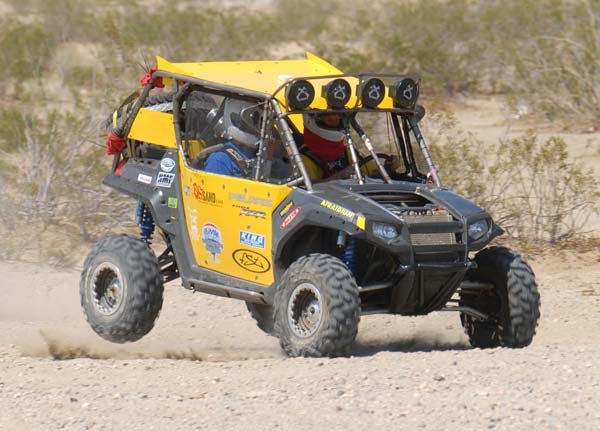
After taking a ride with Lindsay through one of the whoop sections at the Stoddard Valley Off-Highway Vehicle Area, it is immediately clear that there is lots of work to be done. The rear of the car bucks like a bronco over every single whoop, the back tires spending more time in the air than on the ground. That Lindsay and co-driver Phil Holdsworth finished – let alone won – the Baja 500 with such a bouncy ride is a testament to the team’s determination. Afraidium Racing certainly deserves all the credit in the world for earning its place in history as the first UTV finisher and winner of the grueling race, but one wonders if its winning time of 19 hours, 49 minutes and 30 seconds, just under the SCORE time limit of 20 hours for the race, could have been significantly lower had the rear end been working as it should. Iribe thinks so, without a doubt.
“To put it simply, he is about as far out as he could be,” Iribe says after riding in the Afraidium RZR. “What’s going on here is that this vehicle has too much spring, and this a very common mistake in off-road racing. When the shock starts bottoming out, the first think that people think is that they need more spring rate to control it, but that is the wrong way to go. It doesn’t need more spring, it needs more shock.”
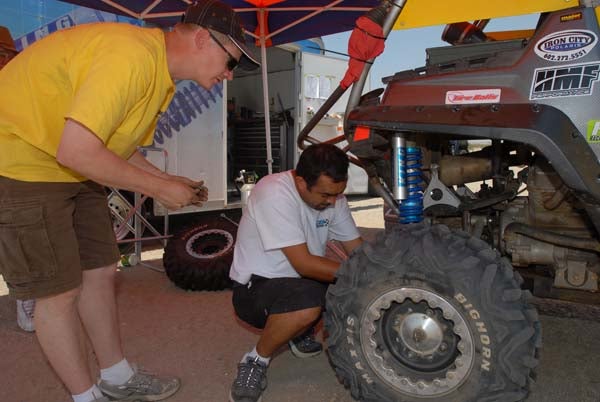
With the shocks removed, Iribe (above right) and fellow tech Ross King, son of King Shocks founder Lance King, discover that the RZR has been set up with 650-pound upper and 500-pound lower springs on each rear shock, way too much for the little UTV even when fully loaded with all the tools and spares it carries during a race in Baja. Regardless of the spring rate, the suspension will still compress under a load. The problem is that without enough rebound dampening, it will want to unload just as quickly, upsetting the vehicle as it travels across the desert floor. Lowering the spring rate and increasing the damping will allow RZR to follow rather than spring off the bumps.
“At King we have four or five different piston designs where we can double, triple or quadruple the dampening of the car by putting one of them into the shock,” Iribe says. “Adding more dampening will slow the movement of the shock shaft. The shock shaft speed is moving way too quickly, so we need to slow it down, make it tighter or stiffer – although it is not really stiffer. You only need enough spring to carry the weight of the vehicle. Right now this thing has double the spring rate that it needs, and that’s why it is kicking so badly.”
More rebound damping is better? If only it were that simple. The key is in finding the balance between too much and too little compression and rebound at both high and low shock speeds (not to be confused with the actual velocity the vehicle itself is traveling). That’s where King’s expertise is invaluable.
“You can keep adding rebound control, and that might help you if you only hit one G-out, but what happens if you are moving fast through a bunch of G-outs?“ Iribe says. “The tire needs to drop in and out fast, and with too much rebound dampening it will start to ‘pack.’ In other words, the wheel will start to skip across the bumps, which is really the worst of all scenarios.”
The Man Who Made It Happen
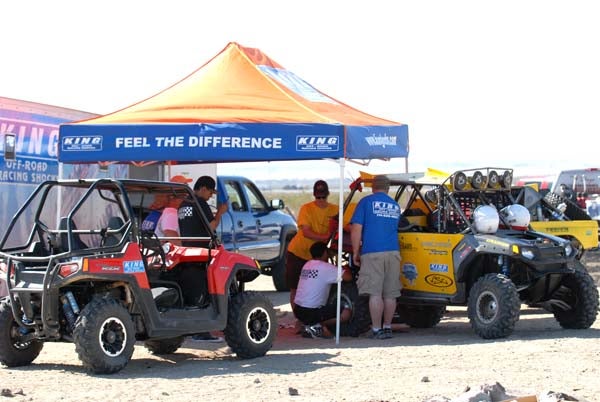
While he may build a hell of a UTV for desert racing, Lindsay is the first person to admit that he is not a shock expert.
“That’s why we came here,” Lindsay says. “I am not a shock expert. It says a lot about the company that these guys will come out here and work with us.”
Lindsay purchased this RZR last July, right when they first came out, and immediately took it to FST Motorsports in Phoenix. FST built the cage, added the fuel cell and built the long travel suspension. The FST crew had tested all different sorts of shocks for the RZR before deciding to recommend King shocks to Lindsay.
“The Kings treated us well down in Baja, but we know there is room for improvement. That’s why we’re here. After riding in their [test] vehicle, I thought it was great. It got me excited because their stock vehicle was very impressive, and our vehicle has a lot more suspension travel than theirs.”
Lindsay is a former ATV racer who recently turned to UTVs.
“I’m 41 now, and I’m a lot more comfortable in the UTV,” Lindsay says. “You know what they say, with age comes the cage. It’s a great class, and it is a growing class. “The UTVs are one of the fastest growing classes anywhere. A lot of people have them, and honestly, it doesn’t take that much to convert one into a racing machine and go out and have a lot of fun. There is no expense here like a Class 1, a Trophy Truck or even a Class 12 car. Anyone can go out and do this.”
But not anyone can earn a victory in the Baja 500. Lindsay’s win in the RZR not only made history, it drew the attention of Polaris, which has agreed to assist Afraidium Racing for the rest of the 2008 season.
Dialing It In
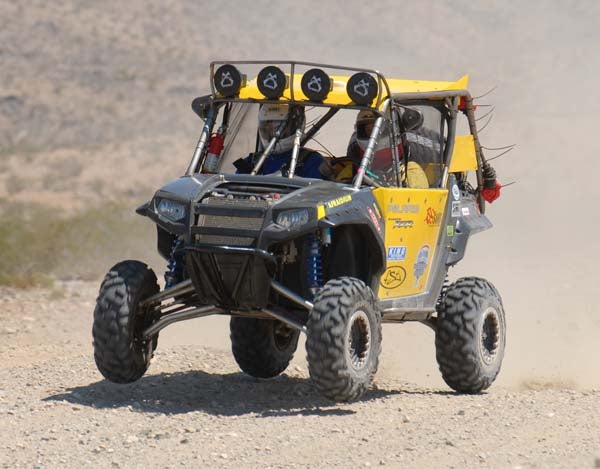
Meanwhile, testing at Stoddard Valley continues to be a bit more of a challenge than even the King guys anticipated. While lowering the spring rate and revalving the Afraidium Racing RZR has already brought about drastic improvements, the team just can’t seem to settle down the rear end of the UTV, prompting King Shocks owner Lance King, who has came along to get away from the daily grind of King’s Garden Grove, California, facility, to make his own suggestions.
“It needs to have at least an inch to two inches of suspension droop,” Lance King says. “You need to have the vehicle be able to drop into a hole from ride height. “From ride height to full extension with the wheel is equally as important as the bump travel. When you are dealing with depressions on the course, it is important for the wheel to be able to drop down and follow that depression.
“You start by fixing the worst problem you have,” King adds. “Watching this car, we saw what the front end was doing, but the rear end was by far the worse. We’ll try to get that pretty close first, and then we’ll start to work on the front and find the balance. That’s the whole object, to get the front and rear working together.”
It is late in the day when, after dropping the spring rates over 200 pounds per side and revalving the shocks twice that Lindsay heads for a pass across the whoops and returns with an ear-to-ear grin. The change is obvious. Instead of kicking, the rear end settles in through the ruts and whoops, keeping the tires firmly planted on the ground and following the front. To watch the RZR as it passes by, it is clear that the rear end is dialed in to the max. Finally, it’s right.
“The last ride was just awesome,” an excited Lindsay said. “The final spring change on the rear end totally changed everything. It’s just like Iribe said, our situation was a very common one. We were hitting the whoops 10 mph faster than we were at the beginning of the day, and if you can increase your speed by 10 mph in rough sections like that, over a long race that is going to be huge.”
It’s just another day at the office for Iribe and Ross King.
“We finally settled on 400-pound upper and 350-pound lower rates,” Iribe said. “It originally had 650 upper and 500 lower. Then we used what we call our ‘bumpstop’ piston, which has the same amount of compression on both sides of the piston. Normally, a shock will have half the amount of compression as rebound, so if you look at the piston, the compression side has six holes while the rebound side has three. What we did is put one that is on both sides – we use that one in our steering stabilizers a lot. What we’re doing is doubling the pressure, basically.”
To further influence the dampening effect, the King crew chose a piston with .060 bleed holes but then restricting oil flow by downsizing the reservoir port and lowering the pressure on the reservoir to enhance shock cooling.
“Now we’re going run the Best in the Desert’s Vegas to Reno, and then we are going to run the Baja 1000,” Lindsay said. “Vegas to Reno will be a good test of everything to help us prepare for the Baja 1000.”
With its suspension package more dialed in than ever before, Afraidium Racing has as good a chance as ever to become the first RZR to cross the finish line in the granddaddy of all off-road races, the Tecate SCORE Baja 1000.


 Your Privacy Choices
Your Privacy Choices